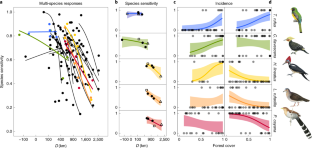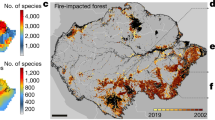Abstract
It is generally assumed that deforestation affects a species consistently across space, however populations near their geographic range edge may exist at their niche limits and therefore be more sensitive to disturbance. We found that both within and across Atlantic Forest bird species, populations are more sensitive to deforestation when near their range edge. In fact, the negative effects of deforestation on bird occurrences switched to positive in the range core (>829 km), in line with Ellenberg’s rule. We show that the proportion of populations at their range core and edge varies across Brazil, suggesting deforestation effects on communities, and hence the most appropriate conservation action, also vary geographically.
This is a preview of subscription content, access via your institution
Access options
Access Nature and 54 other Nature Portfolio journals
Get Nature+, our best-value online-access subscription
$29.99 / 30 days
cancel any time
Subscribe to this journal
Receive 12 digital issues and online access to articles
$119.00 per year
only $9.92 per issue
Buy this article
- Purchase on Springer Link
- Instant access to full article PDF
Prices may be subject to local taxes which are calculated during checkout



Similar content being viewed by others
Data availability
Bird occurrence datasets and derived datasets are available from https://osf.io/4pbzt/. We do not have rights to redistribute the underlying forest cover (SOS Mata Atlântica, Instituto Florestal) and range polygon (BirdLife) data, but these datasets are available for use under licence.
Code availability
Code used to perform the analysis is available from https://osf.io/4pbzt/.
Change history
11 June 2019
An amendment to this paper has been published and can be accessed via a link at the top of the paper.
References
Barnosky, A. D. et al. Has the Earth’s sixth mass extinction already arrived? Nature 471, 51–57 (2011).
Hockey, P. A. R. & Curtis, O. E. Use of basic biological information for rapid prediction of the response of species to habitat loss. Conserv. Biol. 23, 64–71 (2009).
Henle, K., Davies, K. F., Kleyer, M., Margules, C. R. & Settele, J. Predictors of species sensitivity to fragmentation. Biodivers. Conserv. 13, 207–251 (2004).
Bregman, T. P., Şekercioğlu, Ç. H. & Tobias, J. A. Global patterns and predictors of bird species responses to forest fragmentation: implications for ecosystem function and conservation. Biol. Conserv. 169, 372–383 (2014).
Watson, J. E. M., Whittaker, R. J. & Freudenberger, D. Bird community responses to habitat fragmentation: how consistent are they across landscapes? J. Biogeogr. 32, 1353–1370 (2005).
Hatfield, J. H., Orme, C. D. L., Tobias, J. A. & Banks-Leite, C. Trait-based indicators of bird species sensitivity to habitat loss are effective within but not across data sets. Ecol. Appl. 28, 28–34 (2018).
Slatyer, R. A., Hirst, M. & Sexton, J. P. Niche breadth predicts geographical range size: a general ecological pattern. Ecol. Lett. 16, 1104–1114 (2013).
Hargreaves, A. L., Samis, K. E. & Eckert, C. G. Are species’ range limits simply niche limits writ large? A review of transplant experiments beyond the range. Am. Nat. 183, 157–173 (2014).
Lee-Yaw, J. A. et al. A synthesis of transplant experiments and ecological niche models suggests that range limits are often niche limits. Ecol. Lett. 19, 710–722 (2016).
dos Anjos, L., Holt, R. D. & Robinson, S. K. Position in the distributional range and sensitivity to forest fragmentation in birds: a case history from the Atlantic forest, Brazil. Bird Conserv. Int. 20, 392–399 (2010).
Uezu, A. & Metzger, J. P. Vanishing bird species in the Atlantic Forest: relative importance of landscape configuration, forest structure and species characteristics. Biodivers. Conserv. 20, 3627–3643 (2011).
Doherty, P. F. J. F., Boulinier, T. & Nichols, J. D. Local extinction and turnover rates at the edge and interior of species’ ranges. Ann. Zool. Fenn. 40, 145–153 (2003).
Pérez-Tris, J., Carbonell, R. & Tellería, J. L. Abundance distribution, morphological variation and juvenile condition of robins, Erithacus rubecula (L.), in their Mediterranean range boundary. J. Biogeogr. 27, 879–888 (2000).
Julliard, R., Clavel, J., Devictor, V., Jiguet, F. F. & Couvet, D. Spatial segregation of specialists and generalists in bird communities. Ecol. Lett. 9, 1237–1244 (2006).
Mace, G. M. et al. Quantification of extinction risk: IUCN’s system for classifying threatened species. Conserv. Biol. 22, 1424–1442 (2008).
Goerck, J. M. Patterns of rarity in the birds of the Atlantic Forest of Brazil. Conserv. Biol. 11, 112–118 (1997).
Orme, C. D. L. et al. Global patterns of geographic range size in birds. PLoS Biol. 4, e208 (2006).
Banks-Leite, C. et al. Using ecological thresholds to evaluate the costs and benefits of set-asides in a biodiversity hotspot. Science. 345, 1041–1045 (2014).
Lindell, C. A. et al. Edge responses of tropical and temperate birds. Wilson J. Ornithol. 119, 205–220 (2007).
Des Roches, S. et al. The ecological importance of intraspecific variation. Nat. Ecol. Evol. 2, 57–64 (2018).
Hynes, H. B. N. The Biology of Polluted Waters (Liverpool Univ. Press, 1980).
Banks-Leite, C., Ewers, R. M., Kapos, V., Martensen, A. C. & Metzger, J. P. Comparing species and measures of landscape structure as indicators of conservation importance. J. Appl. Ecol. 48, 706–714 (2011).
Péron, G. & Altwegg, R. The abundant centre syndrome and species distributions: insights from closely related species pairs in southern Africa. Glob. Ecol. Biogeogr. 24, 215–225 (2015).
Bahn, V., J. O’Connor, R. & Krohn, W. B. Effect of dispersal at range edges on the structure of species ranges. Oikos 115, 89–96 (2006).
Crawley, M. J. Plant Ecology (Blackwell, 1997).
Marini, M. A. & Garcia, F. I. Bird conservation in Brazil. Conserv. Biol. 19, 665–671 (2005).
Brooks, T. & Balmford, A. Atlantic forest extinctions. Nature 380, 115 (1996).
SOS Mata Atlântica & Instituto Nacional de Pesquisas Espaciais. Atlas dos Remanescentes florestais da Mata Atlântica no Período 2013–2014 (2015); http://www.spsma.org.br
Instituto Florestal. Inventário florestal do Estado de São Paulo (2010); http://www.ambiente.sp.gov.br
Pebesma, E. sf: Simple Features for R. R package v.0.5-3 https://cran.r-project.org/package=sf (2017).
R Core Team. R: A Language and Environment for Statistical Computing (R Foundation for Statistical Computing, 2017); http://www.R-project.org/
Hatfield, J. H., Orme, C. D. L. & Banks-Leite, C. Using functional connectivity to predict potential meta-population sizes in the Brazilian Atlantic Forest. Perspect. Ecol. Conserv. 16, 215–220 (2018).
Boscolo, D. & Metzger, J. Is bird incidence in Atlantic forest fragments influenced by landscape patterns at multiple scales?. Landsc. Ecol. 24, 907–918 (2009).
BirdLife International and NatureServe. Bird Species Distribution Maps of the World (2017); http://datazone.birdlife.org/
Banks-Leite, C. et al. Assessing the utility of statistical adjustments for imperfect detection in tropical conservation science. J. Appl. Ecol. 51, 849–859 (2014).
Gauch, H. G. Multivariate Analysis In Community Ecology (Cambridge Univ. Press, 1982).
Banks-Leite, C. & Cintra, R. The heterogeneity of Amazonian treefall gaps and bird community composition. Ecotropica 14, 1–13 (2008).
Morante-Filho, J. C., Faria, D., Mariano-Neto, E. & Rhodes, J. Birds in anthropogenic landscapes: the responses of ecological groups to forest loss in the Brazilian Atlantic Forest. PLoS ONE 10, e0128923 (2015).
Bates, D., Maechler, M. & Walker, S. Fitting linear mixed-effects models using lme4. J. Stat. Softw. 67, 1–48 (2015).
Lefcheck, J. S. piecewiseSEM: piecewise structural equation modelling in R for ecology, evolution, and systematics. Methods Ecol. Evol. 7, 573–579 (2016).
Acknowledgements
We thank R. D. Holt, C. Rahbek, M. J. Crawley and R. Ewers for comments on the study and manuscript. This paper represents a contribution to the Grand Challenges in Ecosystems and the Environment Initiative of Imperial College. We acknowledge the use of the Imperial College Research Computing Service (https://doi.org/10.14469/hpc/2232). This research was supported by the Natural Environment Research Council (grant nos. NE/H016228/1, NE/K016393/1) and FAPESP (process no. 2012/51872-5).
Author information
Authors and Affiliations
Contributions
L.A., P.F.D., J.H.H., J.C.M., A.U. and C.B.L. collected the data. C.D.L.O., S.M., J.M.T. and C.B.L. analysed the data. C.D.L.O., S.M. and C.B.L. wrote the paper. All authors contributed to the text.
Corresponding author
Ethics declarations
Competing interests
The authors declare no competing interests.
Additional information
Publisher’s note: Springer Nature remains neutral with regard to jurisdictional claims in published maps and institutional affiliations.
Supplementary information
Supplementary Information
Supplementary Figs. 1–4 and Supplementary Tables 1–3
Supplementary Data 1
List of species detected in each study and number of sites in which the species was detected.
Rights and permissions
About this article
Cite this article
Orme, C.D.L., Mayor, S., dos Anjos, L. et al. Distance to range edge determines sensitivity to deforestation. Nat Ecol Evol 3, 886–891 (2019). https://doi.org/10.1038/s41559-019-0889-z
Received:
Accepted:
Published:
Issue Date:
DOI: https://doi.org/10.1038/s41559-019-0889-z
This article is cited by
-
Forest cover positively affects the occurrence of understory insectivorous Passeriformes in bird communities of the Atlantic Forest
Community Ecology (2023)
-
Conservation genetics of a wide-ranged temperate snake: same species, different locations, and different behaviour
Conservation Genetics (2022)
-
Matrix composition mediates effects of habitat fragmentation: a modelling study
Landscape Ecology (2021)
-
Tropical and Mediterranean biodiversity is disproportionately sensitive to land-use and climate change
Nature Ecology & Evolution (2020)
-
The magnitude and extent of edge effects on vascular epiphytes across the Brazilian Atlantic Forest
Scientific Reports (2020)



